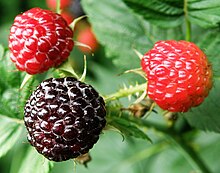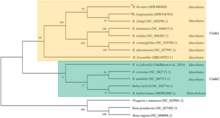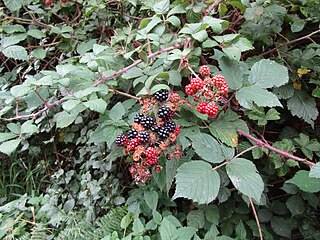
Rubus is a large and diverse genus of flowering plants in the rose family, Rosaceae, subfamily Rosoideae, with over 1,350 species, commonly known as brambles.
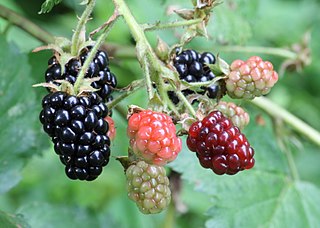
The blackberry is an edible fruit produced by many species in the genus Rubus in the family Rosaceae, hybrids among these species within the subgenus Rubus, and hybrids between the subgenera Rubus and Idaeobatus. The taxonomy of blackberries has historically been confused because of hybridization and apomixis, so that species have often been grouped together and called species aggregates. For example, the entire subgenus Rubus has been called the Rubus fruticosus aggregate, although the species R. fruticosus is considered a synonym of R. plicatus.

The dewberries are a group of species in the genus Rubus, section Rubus, closely related to the blackberries. They are small trailing brambles with aggregate fruits, reminiscent of the raspberry, but are usually purple to black instead of red.

The boysenberry is a cross between the European raspberry, European blackberry, American dewberry, and loganberry.

Rubus chamaemorus is a species of flowering plant in the rose family Rosaceae, native to cool temperate regions, alpine and Arctic tundra and boreal forest. This herbaceous perennial produces amber-colored edible fruit similar to the blackberry. English common names include cloudberry, Nordic berry, bakeapple, knotberry and knoutberry, aqpik or low-bush salmonberry, and averin or evron.

The raspberry is the edible fruit of a multitude of plant species in the genus Rubus of the rose family, most of which are in the subgenus Idaeobatus. The name also applies to these plants themselves. Raspberries are perennial with woody stems.

Rubus idaeus is a red-fruited species of Rubus native to Europe and northern Asia and commonly cultivated in other temperate regions.

Rubus spectabilis, the salmonberry, is a species of bramble in the rose family Rosaceae, native to the west coast of North America from west-central Alaska to California, inland as far as Idaho. Like many other species in the genus Rubus, the salmonberry plant bears edible fruit, typically yellow-orange or red in color, resembling raspberries in appearance.

The loganberry is a hybrid of the North American blackberry and the European raspberry.

The marionberry is a cultivar of blackberry released in 1956 by the USDA Agricultural Research Service breeding program in cooperation with Oregon State University. It is named after Marion County, Oregon, where the berry was bred and tested extensively in the mid-20th century.

Rubus phoenicolasius is an Asian species of raspberry in the rose family, native to China, Japan, and Korea.
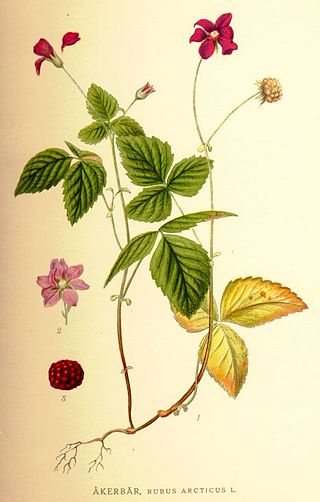
Rubus arcticus, the Arctic bramble or Arctic raspberry, is a species of slow-growing bramble belonging to the rose family, found in Arctic and alpine regions in the Northern Hemisphere.

Rubus leucodermis, also called whitebark raspberry, blackcap raspberry, or blue raspberry, is a species of Rubus native to western North America.

Rubus pensilvanicus, known commonly as Pennsylvania blackberry, is a prickly bramble native to eastern and central North America from Newfoundland south to Georgia, west as far as Ontario, Minnesota, Nebraska, Missouri, and Arkansas. The species is also established as a naturalized plant in California.
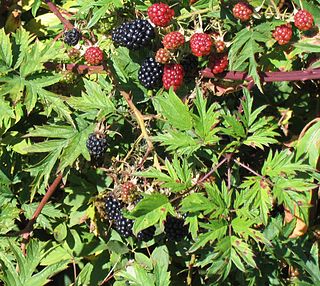
Rubus laciniatus, the cutleaf evergreen blackberry or evergreen blackberry, is a species of Rubus, native to Eurasia. It is an introduced species in Australia and North America. It has become a weed and invasive species in forested habitats in the United States and Canada, particularly in the Northeast and along the Pacific Coast.
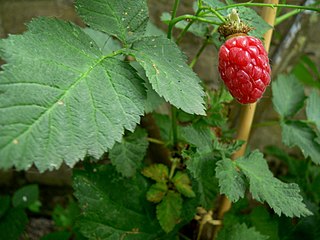
The tayberry is a cultivated shrub in the genus Rubus of the family Rosaceae patented in 1979 as a cross between a blackberry and a red raspberry, and named after the River Tay in Scotland.

Rubus armeniacus, the Himalayan blackberry or Armenian blackberry, is a species of Rubus in the blackberry group Rubus subgenus Rubus series Discolores Focke. It is native to Armenia and northern Iran, and widely naturalised elsewhere. Both its scientific name and origin have been the subject of much confusion, with much of the literature referring to it as either Rubus procerus or Rubus discolor, and often mistakenly citing its origin as western European. Flora of North America, published in 2014, considers the taxonomy unsettled, and tentatively uses the older name Rubus bifrons.

Rubus ursinus is a North American species of blackberry or dewberry, known by the common names California blackberry, California dewberry, Douglas berry, Pacific blackberry, Pacific dewberry and trailing blackberry.

Rubus coreanus, known as bokbunja, Korean blackberry, or Korean bramble, is a species of raspberry native to Korea, Japan, and China. It produces edible berries that can be fermented into bokbunja ju, a Korean fruit wine. R. coreanus fruits are usually harvested between the May and July at peak harvest season. They can only be cultivated in a few areas in Korea, different to Rubus occidentalis, which can be cultivated widely across the country.
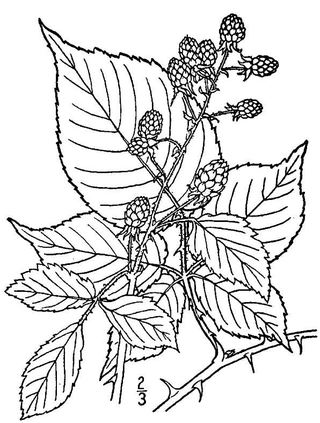
Rubus allegheniensis is a North American species of highbush blackberry in Section Alleghenienses of the genus Rubus, a member of the rose family. It is the most common and widespread highbush blackberry in eastern and central North America. It is commonly known as Allegheny blackberry.
